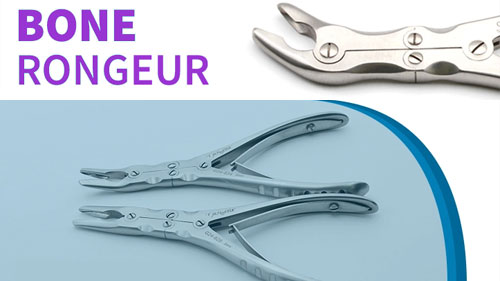
A dentist demands top-notch quality dental instruments to make any therapy effective, whether it is tooth straightening, scaling, extraction, carnies’ removal, corrective treatment, root canal, fixing vital dental braces, and even more. But, above all, the most famous surgery taking place worldwide is plastic surgery to improve the patient’s smile. Thus, all dental procedures require a broad range of instruments. One such handy instrument is bone rongeur that consists of two pointed jaws to extract a tooth easily. This tool is used when there is no other option to fix the original tooth by any treatment rather than mining it. So, without any delay, let’s dig down to know more about this handy tool of dentistry.
Design And Usage
This instrument consists of pointed jaws and hard-duty material similar to the pliers. The construction of this tool is lightweight, but it can sturdily grip the bones for gauging holes in dental surgery. In addition, it has a scoop-shaped tip that helps the surgeon remove any decayed or cracked teeth with minimal exertion. This tool can chip off the oral tartar. Further, this dental tool is well-suited for several dissecting dentistry procedures. It can assist the surgeon in reaching the targeted area feasibly.
Below are some popular designed patterns of the bone rongeur to make the surgery outcomes even more competent for all patients. Read on!
Beyer Bone Rongeur
This ergonomically designed rongeur tool has sharp edges that assist in tooth extraction. Plus, it is lightweight and rustproof due to the German stainless material. Besides, this tool has a length of 18 cm, pointy tips, and a self-locking mechanism. Also, the double-ended tip adds assistance in handling the bones, tissues, ligaments, and more Above all, it is sharp enough last for many years without requiring sharpening and delivering unsurpassed results.
Micro Friedman Bone Rongeurs
It is an amazing variation of rongeur that can assist the dentist in gouging out the bones in dental practices. It is composed of German surgical stainless with an overall length of 5 1/2″, 14.5 cm. Besides, the structure has a straight pattern with a double spring handle. Due to this spring mechanism, the holder does not need to exert much pressure while extracting a tooth. It is available in several angled tips, including 90 and 45 degrees.
Blumenthal Bone Rongeur
This disparity in rongeur is required when the dentist has to remove the inter-radicular bone in the surgery. Plus, it consists of a double spring plier mechanism for easier handling during tooth extraction. The tool has a length of 15cm with a curved pattern. No doubt, the quality is highly durable due to german stainless material. Likewise, this tool will let the surgeon have complete access to the hard-to-reach areas of the mouth. Not only this, you can find the dental tool in several distinctions for the best support in several instances.
Ruskin-Mini Bone Rongeur
Ruskin is another useful distinction of the dental rongeur tool in 15.5cm for feasible trimming and re-contouring of the alveolar bone. Plus, it is ideal for removing the tissues while performing any dental surgery. In addition, this instrument consists of a double-action spring mechanism with the jaws of the scoop type. The structure of this tool allows the dentist to grasp the bone. As well, it can assist in creating large spaces feasibly.
To Sum Up
Rongeur forceps does not only have a limited usage, but it is suitable for many dental surgeries and mostly dentist like maven dental yeronga, use this tool. Indeed, it is crucial to choose a rongeur that fits according to your surgery type. This high-quality German forged rustproof tool will prevent cross-contamination. Subsequently, this implausible dental tool has great importance from the groundwork to the outcomes of the surgeries.





